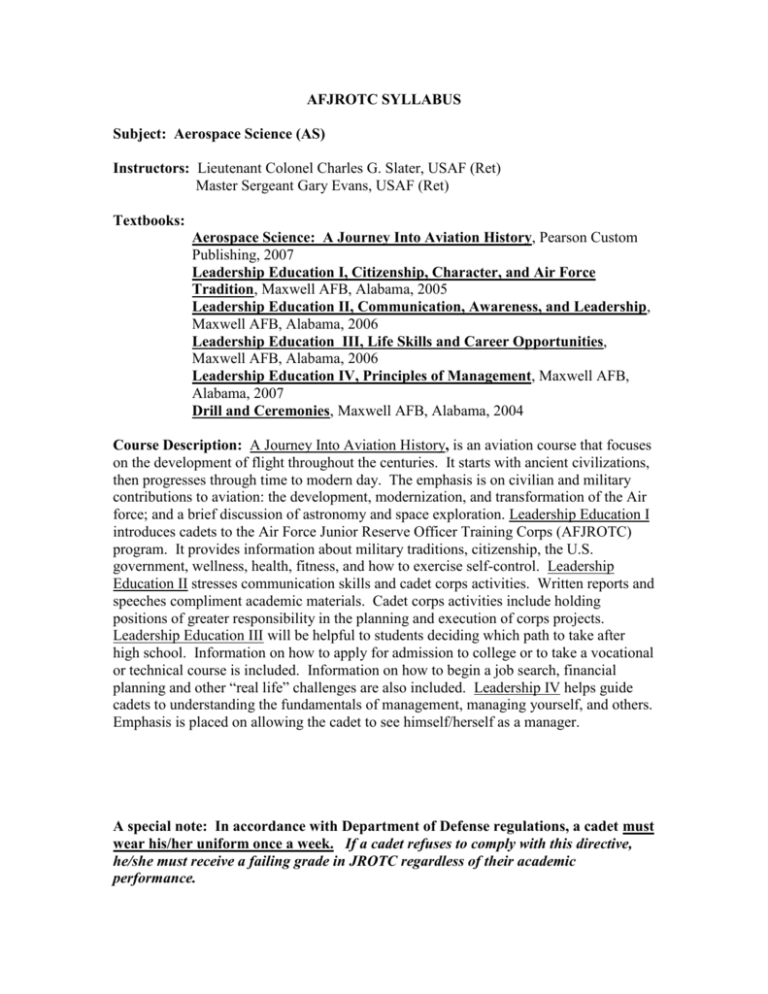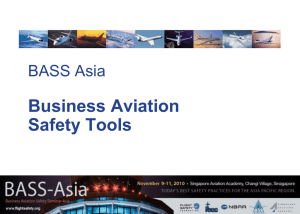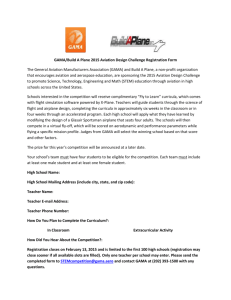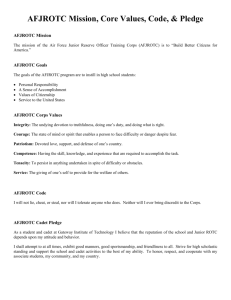AFJROTC SYLLABUS - Cherokee County Schools
advertisement

AFJROTC SYLLABUS Subject: Aerospace Science (AS) Instructors: Lieutenant Colonel Charles G. Slater, USAF (Ret) Master Sergeant Gary Evans, USAF (Ret) Textbooks: Aerospace Science: A Journey Into Aviation History, Pearson Custom Publishing, 2007 Leadership Education I, Citizenship, Character, and Air Force Tradition, Maxwell AFB, Alabama, 2005 Leadership Education II, Communication, Awareness, and Leadership, Maxwell AFB, Alabama, 2006 Leadership Education III, Life Skills and Career Opportunities, Maxwell AFB, Alabama, 2006 Leadership Education IV, Principles of Management, Maxwell AFB, Alabama, 2007 Drill and Ceremonies, Maxwell AFB, Alabama, 2004 Course Description: A Journey Into Aviation History, is an aviation course that focuses on the development of flight throughout the centuries. It starts with ancient civilizations, then progresses through time to modern day. The emphasis is on civilian and military contributions to aviation: the development, modernization, and transformation of the Air force; and a brief discussion of astronomy and space exploration. Leadership Education I introduces cadets to the Air Force Junior Reserve Officer Training Corps (AFJROTC) program. It provides information about military traditions, citizenship, the U.S. government, wellness, health, fitness, and how to exercise self-control. Leadership Education II stresses communication skills and cadet corps activities. Written reports and speeches compliment academic materials. Cadet corps activities include holding positions of greater responsibility in the planning and execution of corps projects. Leadership Education III will be helpful to students deciding which path to take after high school. Information on how to apply for admission to college or to take a vocational or technical course is included. Information on how to begin a job search, financial planning and other “real life” challenges are also included. Leadership IV helps guide cadets to understanding the fundamentals of management, managing yourself, and others. Emphasis is placed on allowing the cadet to see himself/herself as a manager. A special note: In accordance with Department of Defense regulations, a cadet must wear his/her uniform once a week. If a cadet refuses to comply with this directive, he/she must receive a failing grade in JROTC regardless of their academic performance. Quarter Grading: Semester Grading: Tests (closed book)/Projects: 40% 1st Quarter: 50% Uniform Wear (weekly): 40% 2nd Quarter: 50% Homework: 10% Physical Training: (every other week): 10% Classroom procedures are outlined in detail in the cadet guide (which will be reviewed in class). Of course, all procedures emphasize good citizenship and preparation for a successful future. Testable Objectives: Aerospace Science: A Journey Into Aviation History: 1. Know how humans tried to fly in ancient times. 2. Know key aviation devices created during ancient times. 3. Know why machines do not fly the way bird do. 4. Know the developments in lighter-than-air flight from Leonardo da Vinci to the Wright Brothers. 5. Know ways balloons were used during the Civil War. 6. Know ways the balloon contributed to US victory in the Battle of San Juan Hill during the Spanish-American War. 7. Know the developments in heavier-than-air flight from da Vinci to the Wright Brothers. 8. Know how the Wright brothers succeeded in the first flight. 9. Know the anatomy of the “Wright Flyer.” 10. Know the principles of airplane flight. 11. Know the history of the Wright brothers’ involvement with the U.S. Army. 12. Know the key individuals involved in early aircraft development. 13. Know the names and anatomy of period aircraft. 14. Know the significance of other American pioneers in aviation following the Wright brothers. 15. Know the contributions of U.S. pilots during World War I. 16. Know the role of air power in World War I. 17. Know the ways air power expanded during World War I. 18. Know who barnstormers were. 19. Know the major contributions of the barnstormers. 20. Know how the barnstormers contributed to public awareness of aviation. 21. Know early developments in commercial flight. 22. Know about the use of the airplane in delivering mail. 23. Know about the development and use of helicopters. 24. Know the predecessors of the U.S. Air Force. 25. Know how the Army Air Corps developed. 26. Know the Air Force’s path toward independence. 27. Know the role air power played in World War II and its significance. 28. Know how air power was developed during World War II. 29. Know the significance of the Allied air campaigns. 30. Know key developments in commercial aircraft. 31. Know key developments in commercial flight use. 32. Know key contributions to the expansion of commercial flight. 33. Know the significance of the development of the jet engine. 34. Know key developments in the commercial flight industry. 35. Know the pros and cons of commercial flight travel for passengers. 36. Know about the creation of an independent Air Force in 1947. 37. Know what the Cold War was and how it began. 38. Know the U.S. Air Force role in the Berlin Airlift. 39. Know the role of air power in the Korean Conflict. 40. Know the role of air power in the Cuban Missile Crisis. 41. Know the role of air power in the Vietnam War. 42. Know how the U.S. Air Force gained an increasingly significant role in other U.S. military operations. 43. Know key developments in aircraft, missile capability, and nuclear capability during the Cold War. 44. Know the significance of stealth aircraft. 45. Know the role of air power in the Gulf War (Operation Desert Storm). 46. Know the role of air power in Operation Enduring Freedom (OEF). 47. Know the role of air power in Operation Iraqi Freedom (OIF). 48. Know the role of air power in various other U.S. military operations from 1990. 49. Know the objects in the solar system. 50. Know the significant contributions of key early astronomers. 51. Know how developments in rocketry made space exploration possible. 52. Know how the Cold War led to a race in space. 53. Know the key steps in the U.S. and Soviet space programs. 54. Know the key steps in the development of the space program. 55. Know the significance of the phrase, “One small step for (a) man, one giant step for mankind.” 56. Know the key space shuttle missions. 57. Know the purpose of the International Space Station. 58. Know current and anticipated developments in manned air vehicles. 59. Know current and anticipated developments unmanned systems. 60. Know current and anticipated developments in cyber warfare. 61. Know anticipated U.S. Air Force plans for integrating air and space operations. 62. Know the National Aeronautics and Space Administration’s (NASA’s) vision for the future. Leadership Education I: Citizenship, Character, and Air Force Tradition: 1. Students will know the importance of AFJROTC’s history, mission, purpose, goals, and objectives. 2. Students will know military traditions and the importance of maintaining a high standard of dress and personal appearance. 3. Students will know the importance of attitude, discipline, and respect, and why values and ethics are so important. 4. Students will know the importance of individual self-control and that an effective stress management program improves the quality of a person’s life. 5. Students will know why courtesies are rendered to the United States flag and the National Anthem of America. 6. Student will know why it is important to be a good democratic citizen and to be familiar with the different forms of government. 7. Students will understand the value of community service. 8. Students will know the importance of keeping themselves in good physical condition. 9. Students will know basic first aid. Drill and Ceremonies: 1. Students will know when and how to salute. 2. Students will know the procedures for honoring the American flag. 3. Students will know the principles and terms of basic drill movements. 4. Students must be able to pass the “30- Commands” drill test by the end of each semester. Leadership Education II: Communication, Awareness, and Leadership: 1. Students will learn the concepts of effective communication. 2. Students will learn about behavior as it pertains to others and the society in which we live. 3. Students will learn how teams work to succeed in improving quality and productivity. 4. Students will learn about complexities of leadership and why it is essential to the success of the mission. Leadership Education III: Life Skills and Career Opportunities: 1. Students will understand the importance of obtaining a degree or job skill after high school. 2. Students will know how to conduct a proper job search and understand its importance in obtaining worthwhile employment. 3. Students will know the importance of monetary budgeting and long-range financial planning. 4. Students will be highly familiar with the career opportunities available through the federal government, National Aeronautical and Space Administration (NASA), Federal Aviation Administration (FAA), and the United States military. Leadership Education IV: Principles of Management: 1. Students will learn the importance of management. 2. Students will learn the techniques and skills involved in making management decisions. 3. Students will learn the concepts and skills of problem solving, decision making and negotiating. 4. Students will learn the importance of managing yourself and others. Cherokee County Schools do not discriminate on the basis of sex, race, color, national origin, or disability in admissions, in employment, or in access to its educational programs.







